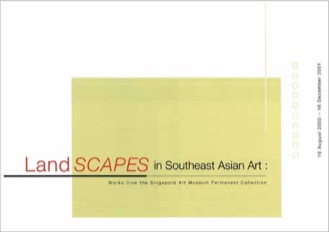Group Exhibition Singapore Art Museum, Singapore
[...] In articulating the term landscape, this exhibition adopts the notion of landscape as space, both physical and notional, one that hosts declarations, interactions and conflicts. In doing so, it allows the exhibition to explore varied manifestations of the landscape. It extends beyond the notion of landscape as records, descriptive or interpretive, of the physical environment and its implication on our understanding about nation, community or identity. Landscape, as an expanded notion includes other manifestations including, the privation of spaces by way of encoding psychological and spiritual states, as well as memory and history. These elements combine to provide a complex mapping of the relationship between artists, their communities and the environments they inhabit. By privileging the idea of landscape as space, the exhibition’s formal interests are widened, allowing the inclusion of sculptures and installations. With these issues in mind, the exhibition is structured along five themes. These themes need not be seen in isolation from one another. Instead, they can be interconnected, where pieces may be interpreted beyond the themes they have been assigned to.


